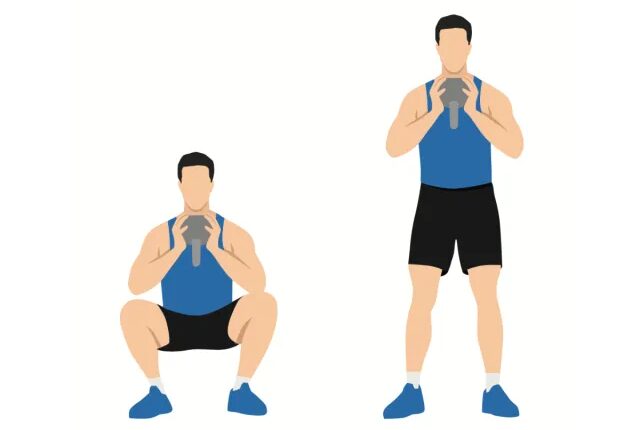In your 70s, it is essential to remain physically active and stick to a consistent exercise regimen. Exercise in this age bracket focuses on important goals such as strength, stability, balance, lean muscle mass, and metabolism. While traditional exercises like squats, lunges, push-ups, rows, and core exercises continue to be valuable, the approach may need adjustments. For instance, instead of heavy barbell squats, you could consider more manageable variations like goblet squats or box squats. These modifications help in ensuring safe and efficient movements as you age, enabling you to maintain strength, resilience, and overall health.
To achieve your fitness objectives effectively, enhance resilience, and improve functional strength beyond 70, it is crucial to engage in specific daily exercises. Ranging from box squats and incline push-ups to single-leg balances and farmer carries, these exercises are designed to keep you active and feeling youthful and energetic. The advantages extend beyond physical health, fostering a sense of achievement and motivation as you progress in your fitness journey.
Discover the top exercises recommended for individuals in their 70s. This overview covers the targeted muscle areas, benefits, execution guidelines, and recommended repetitions for each exercise. Additionally, explore 5 recommended workouts that should be incorporated into your routine for optimal results at this stage of life.
Goblet Box Squat
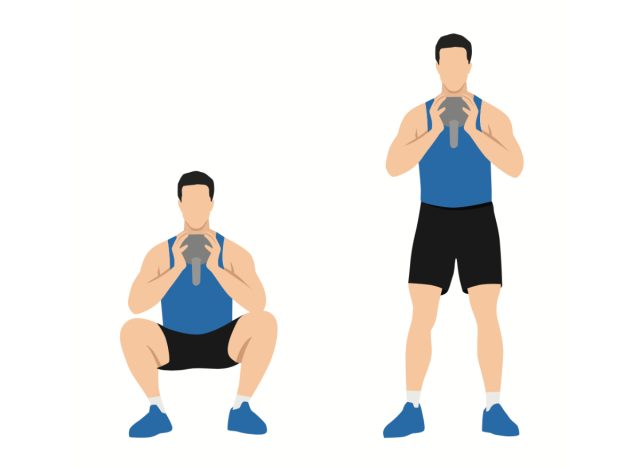

Target areas: This exercise targets the quadriceps, hamstrings, and glutes while engaging the core for stability.
Benefits: The goblet box squat is excellent for maintaining leg strength and improving mobility, which is crucial as we age. Using a box or bench as a guide reduces the risk of going too deep into the squat, protecting your knees and lower back. Holding the weight in front of you helps maintain an upright posture, benefiting those with back issues or who want to improve overall posture. As your strength and mobility improve, don’t hesitate to lower the height of the box or challenge yourself by performing traditional squats.
How to do it: Hold a dumbbell or kettlebell close to your chest. Stand in front of a sturdy box or bench with your feet hip-width apart and toes slightly out. Lower yourself into a squat by bending at the knees and hips simultaneously until you touch the box lightly with your glutes. Stand back up by pushing through your whole foot. Keep your chest up and core engaged throughout the movement.
Reps/Sets: Complete three sets of 8 to 12 reps. Rest for 90 seconds between sets.
Single Leg Balance
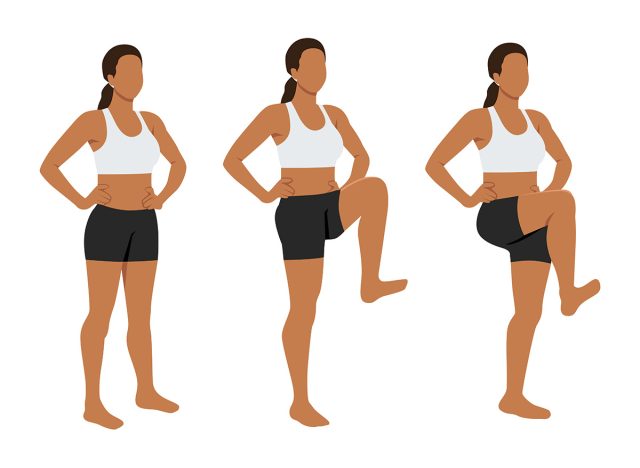

Target areas: This exercise targets the core muscles, quadriceps, hamstrings, glutes, calves, and ankle stabilizers.
Benefits: Balance tends to decline with age, so practicing single-leg balances can help prevent falls and improve overall stability. This exercise enhances proprioception (your sense of body position) and significantly boosts confidence in daily activities. Improving balance can greatly reduce the risk of injuries from falls, which are a common concern for older adults, especially in your 70s and beyond. Regularly practicing single-leg balances strengthens your legs and core muscles, promoting better posture and coordination.
How to do it: Stand on one leg and raise your other leg until it reaches a 90-degree bend at the knee. Hold this position for a few seconds, then switch legs. For an added challenge, try closing your eyes or standing on an unstable surface like a foam pad. Or, for support, use a barbell in a rack or a sturdy post to assist yourself and help you develop strength and confidence for non-supported movements.
Reps/Sets: Perform three sets of 5 to 10 leg raises per side. Rest 90 seconds between sets.
Glute Bridge
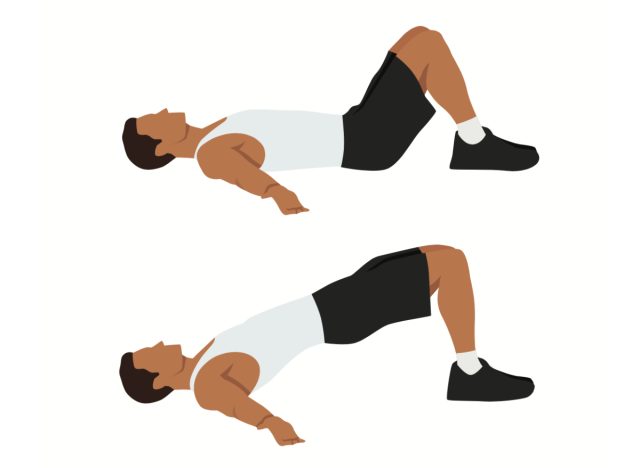

Target areas: This exercise targets the glutes, hamstrings, lower back, and core muscles.
Benefits: Glute bridges strengthen your posterior chain, including your glutes and lower back, alleviating lower back pain and improving posture. This exercise also enhances hip mobility, vital for maintaining ease of movement and preventing stiffness. Additionally, glute bridges can help improve your performance in other activities by providing a solid foundation of strength and stability in your lower body.
How to do it: Lie on your back with your knees bent and feet flat on the floor, hip-width apart. Push through your heels to lift your hips towards the ceiling, squeezing your glutes at the top. Lower back down slowly and repeat. Place a dumbbell in your hip crease to increase the intensity.
Reps/Sets: Complete three sets of 10 to 12 reps. Rest for 90 seconds between sets.
Farmer’s Carry
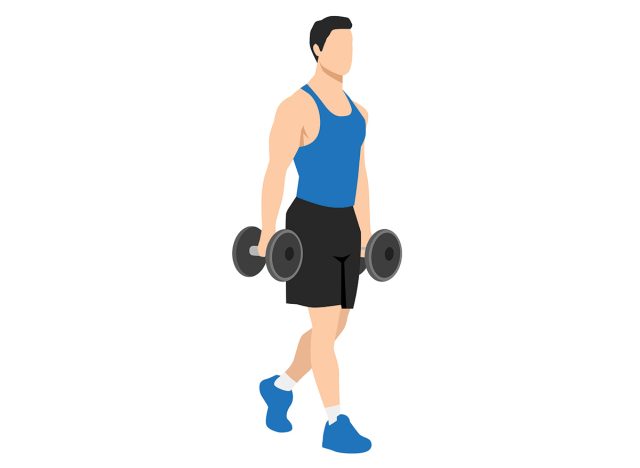

Target areas: The farmer’s carry is a full-body exercise that engages your core, legs, and upper body, making it a highly efficient addition to your fitness routine.
Benefits: Farmer’s carries are excellent for building grip strength, shoulder stability, and overall endurance. This functional exercise mimics the natural movement of carrying heavy objects, making everyday tasks easier and safer. It also helps to improve your walking gait and posture, as you must keep your body upright and stable while carrying the weights.
How to do it: Grab a pair of dumbbells or kettlebells. Stand tall and walk a set distance, keeping your core tight and back engaged. Maintain good posture and walk at a controlled pace.
Reps/Sets: Perform three sets of carries for 30 to 45 seconds each. Rest for 90 seconds between sets.
Suitcase Carry
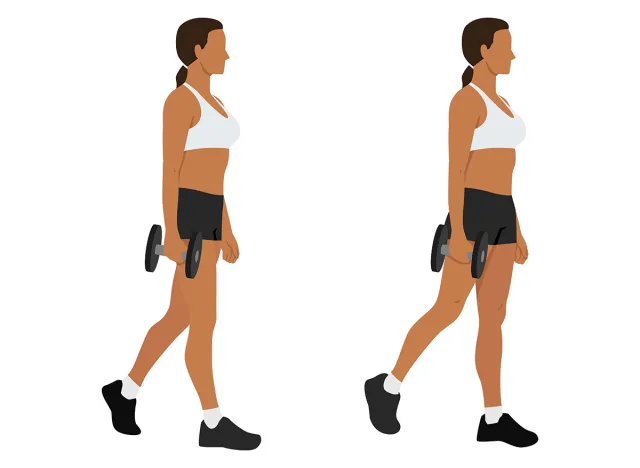

Target areas: This exercise targets the core muscles, obliques, shoulders, grip, glutes, quadriceps, hamstrings, and calves.
Benefits: Similar to the farmer’s carry, the suitcase carry adds an element of asymmetry, forcing your core to work harder to stabilize your body. This exercise improves core strength and balance, ensuring both sides of your body develop equally. The suitcase carry also enhances grip and unilateral strength, ensuring that both sides of your body develop equally. This functional movement is highly relevant to daily activities, such as carrying a bag or suitcase, and can help prevent injuries by promoting better body mechanics.
How to do it: Hold a dumbbell or kettlebell in one hand at your side. Walk a set distance while maintaining a straight posture, then switch hands and repeat. Keep your core engaged throughout. Place your non-carry hand on your abs to feel your core staying engaged.
Reps/Sets: Complete three sets of carries for 30 to 45 seconds per side. Rest for 90 seconds between sets.
Incline Push-Up
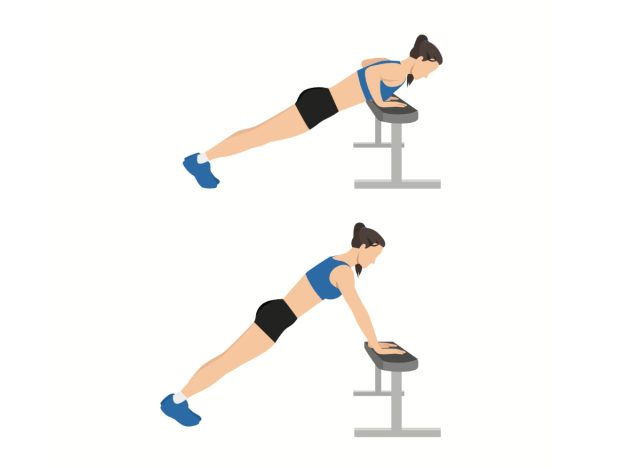

Target areas: Incline push-ups reduce strain on your shoulders and wrists compared to traditional push-ups while effectively working your chest, shoulders, and triceps.
Benefits: This variation is accessible and less intimidating, especially for building or maintaining upper body strength. Incline push-ups can also help improve your core stability, as you must keep your body straight throughout the movement. By adjusting the incline height, you can tailor the difficulty to your fitness level, making it a versatile exercise for continuous improvement.
How to do it: Place your hands on a sturdy surface like a bench or racked barbell, slightly outside of shoulder width. Walk your feet back until your body forms a straight line. Slowly lower your chest towards the surface, keeping your glutes and abs engaged. Then, push back up to the starting position.
Reps/Sets: Perform three sets of 5 to 10 reps. Rest for 90 seconds between sets.
Landmine Press
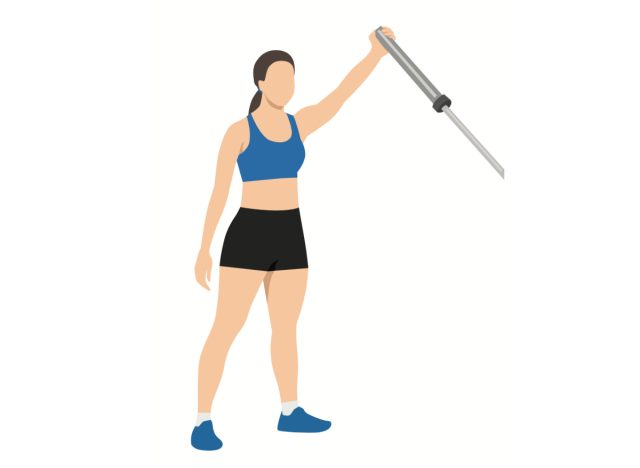

Target areas: The landmine press engages multiple muscle groups, including your shoulders, chest, and triceps, while activating your core to maintain balance.
Benefits: The landmine press is a shoulder-friendly exercise that builds upper body strength and improves core stability. It’s particularly beneficial for those with shoulder issues, as it allows for a more natural pressing motion that reduces the risk of impingement. This exercise can help improve your overall upper body strength and functional fitness, making it easier to perform daily tasks that require pushing or lifting.
How to do it: Secure one end of a barbell in a landmine attachment or corner of a squat rack. Hold the other end with both hands at shoulder height. Press the barbell up and forward, then lower it back to the starting position. Explore variations such as two-arm and single-arm landmine presses, and switch up your stances using options like staggered stance, half-kneeling, and tall-kneeling.
Reps/Sets: Complete three sets of 6 to 12 reps per side. Rest 90 seconds between sets.
Pallof Holds
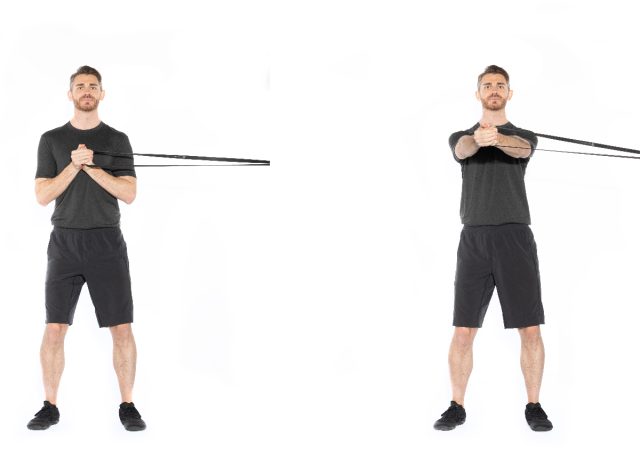

Target areas: The Pallof hold is an excellent core exercise that enhances stability and resistance to rotational forces.
Benefits: It is great for building a strong, stable core to protect your lower back and improve overall movement efficiency. By resisting the pull of the resistance band, you engage your deep core muscles, which are essential for maintaining proper posture and preventing injuries.
How to do it: Attach a resistance band to a fixed point or set a cable machine at chest height. Stand perpendicular to the band or handle with your feet shoulder-width apart. Hold the band or handle with both hands and extend your arms straight out in front of you. Hold this position, resisting the band’s pull by squeezing your abs, then switch sides.
Reps/Sets: Perform three sets of 15 to 30-second holds per side. Rest 90 seconds between sets.
Bodyweight Lunge
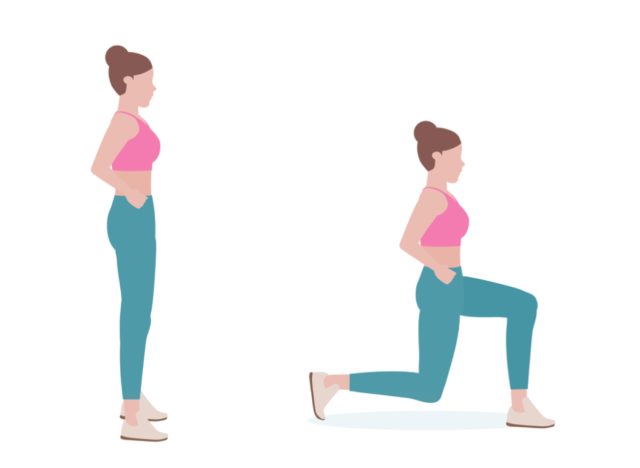

Target areas: Lunges are fantastic for improving leg strength, balance, and coordination. They target the quadriceps, hamstrings, and glutes while engaging the core for stability.
Benefits: Lunges help maintain mobility and flexibility in your hips and knees, which are essential for daily activities such as walking, climbing stairs, and bending. This exercise can also enhance your balance and proprioception, reducing the risk of falls and injuries. You can adapt bodyweight lunges to any setting, making them a convenient addition to your fitness routine.
How to do it: Stand with your feet hip-width apart. Step forward with one leg and lower your body until both knees bend to 90-degree angles. Push back through your whole front foot to the starting position and switch legs.
Reps/Sets: Perform three sets of 10 to 12 reps per leg. Rest 90 seconds between sets.
TRX Row
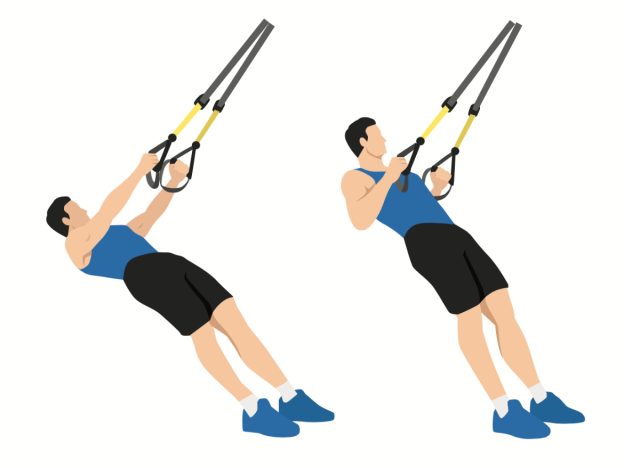

Target areas: TRX rows are a versatile exercise that strengthens your back, shoulders, and arms while engaging your core.
Benefits: The adjustable nature of the TRX allows you to tailor the difficulty to your fitness level, making it accessible for everyone. This exercise promotes better posture by targeting the upper back muscles, which can help counteract the effects of prolonged sitting or slouching. TRX rows also improve your grip strength and overall upper-body endurance. The best part is that TRX rows are versatile and accommodating, quickly adjusting for various fitness and strength levels.
How to do it: Hold the TRX handles with your palms facing each other and lean back, keeping your body straight and hips and core engaged. Pull your chest towards the handles by squeezing your shoulder blades together, then slowly lower yourself back to the starting position.
Reps/Sets: Complete three sets of 8 to 12 reps. Rest for 90 seconds between sets.
FAQs
What are the benefits of exercising daily after 70?
Exercising daily after the age of 70 can help improve balance, strength, flexibility, and overall cardiovascular health. It can also help prevent falls, reduce the risk of chronic diseases, and improve mood and mental well-being.
1. Is it safe to start a new exercise routine after 70?
It is always recommended to consult with a healthcare provider before starting a new exercise routine, especially if you are over 70 or have any underlying health conditions. They can help you determine the safest and most effective exercises for your age and health status.
2. What are some low-impact exercises suitable for seniors over 70?
Low-impact exercises that are suitable for seniors over 70 include walking, swimming, yoga, tai chi, Pilates, cycling, and water aerobics. These exercises are gentle on the joints while still providing a good workout.
3. How often should seniors over 70 exercise?
Seniors over 70 should aim to exercise at least 150 minutes per week, spread out over several days. It is recommended to do a mix of cardiovascular exercise, strength training, and flexibility exercises to reap the most benefits.
4. What are some simple daily exercises that seniors over 70 can do at home?
Some simple daily exercises that seniors over 70 can do at home include chair squats, calf raises, wall push-ups, seated leg lifts, arm circles, and shoulder rolls. These exercises can help improve strength, balance, and flexibility.
5. How can seniors over 70 stay motivated to exercise daily?
Seniors over 70 can stay motivated to exercise daily by setting realistic goals, finding a workout buddy, joining group exercise classes, varying their routine, tracking their progress, rewarding themselves, and focusing on the benefits of regular exercise.
6. Are there any exercises that seniors over 70 should avoid?
Seniors over 70 should avoid high-impact exercises, heavy weightlifting, and exercises that put a lot of strain on the joints, such as running or jumping. It is important to listen to your body and modify exercises as needed to prevent injury.
7. Should seniors over 70 do warm-up and cool-down exercises?
Yes, it is important for seniors over 70 to do warm-up and cool-down exercises before and after their workout to prevent injury, improve performance, and promote flexibility. Gentle stretching, walking, and range-of-motion exercises are beneficial.
8. What role does nutrition play in the exercise routine for seniors over 70?
Nutrition plays a crucial role in the exercise routine for seniors over 70 by providing the necessary nutrients for energy, recovery, and muscle maintenance. It is important to eat a balanced diet rich in fruits, vegetables, lean protein, whole grains, and healthy fats to support an active lifestyle.
9. How can seniors over 70 ensure they are exercising safely?
Seniors over 70 can ensure they are exercising safely by staying hydrated, wearing proper footwear and clothing, using equipment correctly, listening to their body, seeking guidance from fitness professionals, and gradually progressing their exercise intensity to avoid injury.
10. Can seniors over 70 see improvements in their health and fitness through daily exercise?
Yes, seniors over 70 can see significant improvements in their health and fitness through daily exercise. Regular physical activity can lead to increased strength, mobility, endurance, and overall well-being, helping seniors maintain independence and quality of life as they age.

